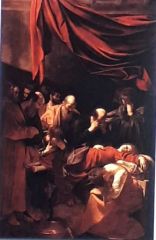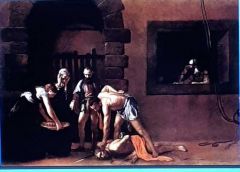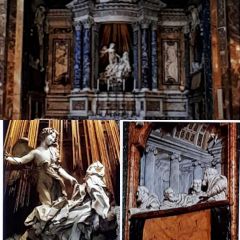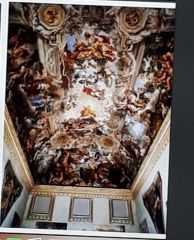![]()
![]()
![]()
Use LEFT and RIGHT arrow keys to navigate between flashcards;
Use UP and DOWN arrow keys to flip the card;
H to show hint;
A reads text to speech;
9 Cards in this Set
- Front
- Back
|
Who is Gabiele Paleotti? 2 points |
-Archbishop of Balogna -influential figure in counter-reformation |
|
|
Instrumentality |
Works of art that serve as instruments of faith |
|

4 points |
Michelangelo Merisi da Caravaggio, Conversion of Saint Paul, 1600-1601 -from the Cerasi Chapel, Rome -chiaroscuro which some contemporaries criticized and went as far as calling it "cellar light" -Biblical story of how Saint Paul was converted to a Christian and then he converted others as well -movement as if God's Grace (the direction of light) is entering the darkness of the material world |
|

3 points |
Michelangelo Merisi da Caravaggio, The Death of the Virgin, c. 1601-1606 -commissioned for Rome's Church of the Scala who rejected it -it was put on public display until the Duke of Mantua purchased it -critiques saying the human emotion in the subject matter is too strong and too realistic and that he made her look like a dirty prostitute |
|

3 points |
Michelangelo Merisi da Caravaggio, The Beheading of Saint John the Baptist, 1608 -done for the knights of Malta to try to prove his nobility after murdering someone -signed his name in his own blood by the Baptist's head which is ambiguous- is he trying to prove his devotion or does he want to make himself look good? Nobody truly knows - he walked around carrying a sword even know he wasn't really a knight |
|

7 points |
Gianlorenzo Bernini, Cornaro Chapel, 1645-1652, Rome -commissioned by Federico Cornaro -an example of a bel composto (beautiful whole) -Bottom left is The Ecstasy of Saint Teresa who was canonized in 1612 and founded the Discalced Carmelite Order -it is an example of transverberation (mystical union with God) and an outward manifestation of an inward experience -Angel is smiling at the implied movement of thrusting the arrow through her chest -Teresa's expression and body language suggest she's aroused by the experience -bottom right image shows how on the sides of Saint Teresa there are sculpted portraits of the Cornaro family |
|

4 points |
Andrea dal Pozzo, Allegory of the Missionary Work of the Jesuits, 1691-1694, Rome -ceiling of the Nave vault In the church of Saint Ignatious Loyala who was canonized (made a saint) in 1622 -example of quadratura (painted illusionistic architecture) -four piers represent four continents (Africa, America, Asia, and Europe) -centre symbolizes the martyrs of the Jesuits |
|

7 points |
Pietro da Cortona, Glorification of the Papacy of Urban VIII, Palazzo Barberini, Rome, 1632-1639 -for Pope Urban VIII -figure of divine providence in the central part of the ceiling (forseeing the future) -time is on left, fate on right -four sides represent four virtues such as wisdom -right panel shows Laurel Wreath and the and representations of the Papacy (crown and two keys), the 3 Christian virtues, and the Barberini bees -symbolism of bees = Egyptian Pharaohs, purity, soul entering heaven, eloquence, good order, etc. - crown with glowing stars symbolize immortality |
|
|
Allegory |
A symbolic representation, meant to be profound in meaning, often complex in form |

